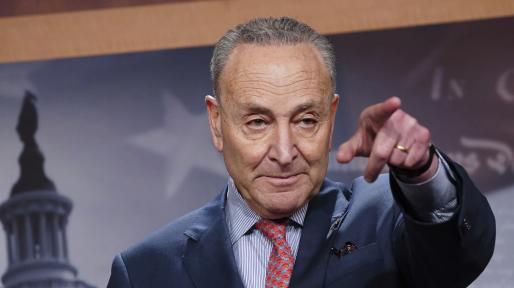Minneapolis Police Chief Medaria Arradondo testified Monday in the murder trial of Derek Chauvin that the now-fired officer defied his own training and the department’s mission of compassion when he kept his knee on the neck of George Floyd for more than 9 minutes last spring.
“Once Mr. Floyd had stopped resisting — and certainly once he was in distress and trying to verbalize that — that should have stopped,” the chief said after spelling out department policy on when to use force vs. calming a situation through de-escalation tactics.
“There’s an initial reasonableness of trying to just get him under control in the first few seconds,” the chief continued, “but once there was no longer any resistance, and clearly when Mr. Floyd was no longer responsive and even motionless, to continue to apply that level of force to a person proned out, handcuffed behind their back, that in no way shape or form is anything that is by policy, part of our training and is certainly not part of our ethics or values.”
Arradondo said that he saw the viral video of Floyd’s arrest that same night, and “when I look at [the bystander’s video] and when I look at the facial expression of Mr. Floyd, that does not appear in any way shape or form [to be] moderate pressure” as department policy requires.
The chief’s assessment complements the testimony last week from veteran Police Lt. Richard Zimmerman, the head of the department homicide unit who called Chauvin’s restraint of Floyd as “uncalled for.”
Under cross examination, defense attorney Eric Nelson asked Arradondo the last time he arrested a suspect. “It’s been many years, sir,” Arradondo said.
COURT TV/POOL
Eric Nelson, left, with client Derek Chauvin Credit: Court TV/pool
Nelson said the department’s use of force policy includes the phrase “In light of facts and circumstances known to that employee at time the force was used.”
“Do people like to be arrested?” Nelson asked, pointing out that people will come up with reasons why they should be arrested, such as a need to attend to a family member.
“Typically not,” Arradondo said.
Under continued questioning, Arradondo acknowledged that officer sometimes need to take control of a situation.
“Would you agree that the use of force is not an attractive notion?” Nelson asked.
“I would say the use of force is something that most officers would rather not use,” Arradondo said.
Arradondo, 54, who has been with the department since 1989 and has been chief for three years, was harshly critical of Chauvin soon after Floyd’s death, which led to widespread unrest and rioting in his city and elsewhere.
Under questioning from prosecutor Steve Schleicher, Arradondo said, “It is my firm belief that the one singular incident we will be judged forever on will be our use of force. While it is absolutely imperative that our officers go home at the end of their shift, we want to make sure our community members do too.”
Arradondo was asked whether the suspicion that brought officers to 38th and Chicago, that Floyd passed to Cup Foods a fake $20 bill, was serious enough to require is arrest.
The chief said it is “typically not” an allegation that leads to someone being detained, because it’s not a violent felony. To reinforce his point, Arradondo said the mere fact of it being a felony-level crime is not enough to prompt an arrest and jailing.
The chief at first walked through his education, training and experience, and acknowledged that officers must use force at times. He also expanded on “to serve with compassion,” a motto emblazoned on the department’s squad vehicles.
“To serve with compassion means to me to understand and authentically accept that we see our neighbors as ourselves, we value one another, we see our community as necessary or our existence,” he said.
Arradondo said he has had to use force and de-escalate tensions, and added that training has vastly improved since he was a cadet more than 30 years ago.
The chief said that every officer must know the contents of the department’s policy manual that covers all requirements of the force and then sign a document to that effect. The prosecution then showed the court Chauvin’s signature on that confirming document.
The prosecution then showed the court the policy entry saying that calls on an officer to not to detain any suspect “no longer than necessary.”
The chief said policing is a “very interesting profession” where a body of work matters, but only internally.
COURT TV/POOL
Eric Nelson, left, with client Derek Chauvin Credit: Court TV/pool
“To our communities your body of work doesn’t hold as much value. We don’t have the luxury of saying, ‘This went really well last time.'”
From there, the prosecutor turned to policies covering officers’ use of force and the preferable use of de-escalation tactics in order to bring an encounter to a safe conclusion for everyone involved.
“You want to keep yourself safe … and you also want to keep your community safe,” Arradondo said.
When interacting with someone who is noncompliant, as Floyd was accused of being by Chauvin, the chief said that sometimes that lack of cooperation is out of a person’s ability. He pointed to several reasons the policy lists for the inability to comply with an officer but highlighted two: being under the influence of drugs or alcohol, and suffering a “behavioral crisis.”
Drug use was suspected of Floyd on the night of his arrest, and Chauvin’s body-camera video captured him that night calling Floyd “crazy.”
“That’s the one [behavioral] that we really need to focus on,” Arradondo said, calling it “the one our men and women … encounter the most.”
A crisis could be because a lost job, death of a loved one or a grave medical diagnosis, the chief said.
“When we respond to calls from our community, it may not be their best day,” the chief said.
Police Chief Medaria Arradondo, with Mayor Jacob Frey. Credit Richarfd Tsong-Taarii/Star Tribune
From the perspective of community members, it’s a sentiment of ” ‘I’m going to grade you on how you treat me during this call, during this interaction,’ so we have to make each engagement with our community count. The training is very important.
“For many in our communities, the first time they encounter a Minneapolis police officer may be the only time in their life; so that singular incident matters.”
Arradondo pointed out that the handling crisis calls is important, saying, “It is not something that they brought upon themselves, so there is a sense of dignity and respect when we go on those calls.”
Schleicher asked whether they should still be treated with respect if they did in part bring the crisis upon themselves. Arradondo said yes, adding, “Oftentimes, we are the first face of government that they are going to see. It may be 3 o’clock in the morning. We wear many hats, but it’s important to be respectful.”
Earlier Monday, the HCMC doctor who declared George Floyd dead late last spring testified Monday in the Derek Chauvin murder trial that there was not a heartbeat “sufficient to sustain life” upon arrival and believed his patient’s cardiac arrest was due to a lack of oxygen.
“Is there another term for that?” prosecutor Jerry Blackwell asked Dr. Bradford Wankhede Langenfeld, who was senior medical resident at the time Floyd was transported to HCMC and eventually pronounced him dead.
“Asphyxia,” Langenfeld said.
The doctor said he went through several known causes of cardiac arrest during his examination of Floyd and concluded that “based on the information that I had, it was more likely” that hypoxia, or a lack of oxygen to the body’s tissues, was responsible for him being stricken over the other possibilities.
COURT TV/POOL
Eric Nelson, left, with client Derek Chauvin Credit: Court TV/pool
As the first witness of the day, Langenfeld described Floyd’s condition and the attempts to resuscitate him.
“When Mr. Floyd was brought in, would you describe it as an emergency situation?” Blackwell asked.
“Yes, absolutely,” Langenfeld said, describing how Floyd was in cardiac arrest and that the goal was to re-establish “spontaneous circulation.”
Asked whether Floyd had a heartbeat upon arrival, the doctor said it was “not to a degree sufficient to sustain life.”
Langenfeld also confirmed earlier evidence that no lifesaving measures performed by the officers or bystanders before Chauvin took his knee off Floyd’s body.
Langenfeld said Floyd was in “PEA” state, which stands for pulseless electrical activity. There was no pulse but some electrical activity. Low oxygen is one of the causes, he said. It then evolved into asystole, or flatlining. He said shocks to the heart cannot bring back people in such states.
Blackwell asked Langenfeld whether Floyd’s cardiac arrest was likely the result of a heart attack. Langenfeld noted that he was not told that Floyd had chest pain or was clutching his chest, along with the fact that he was in a PEA state.
“At the time it was not completely possible to rule that out, but I felt it was less likely based on the information available to us.”
Police Chief Medaria Arradondo, with Mayor Jacob Frey. Credit Richarfd Tsong-Taarii/Star Tribune
As to whether he believed Floyd overdosed, Langenfeld said, “I didn’t feel there was a specific toxin for which we could give a medication that would reverse his arrest.”
After Floyd was in cardiac arrest for 60 minutes, and was in full PEA and asystole, he said there was well below a 1% chance for a good outcome. He said he then pronounced him dead.
Questioning by Nelson focused on illicit drugs, specifically the impact that opioids Fentanyl and methamphetamine, might have had on Floyd’s extremely high carbon dioxide levels in his blood. Such levels can be life-threatening.
The doctor agreed that those drugs, which an autopsy found to be in Floyd’s body, can lead to a lack of oxygen to the body.
Before Monday’s first witness, the proceedings started with Nelson explaining why he wants more of Chauvin’s body-worn camera video from the night of the arrest. Nelson said it showed the “totality of the circumstances” of what happened after Floyd was taken in the ambulance to HCMC.
Prosecutor Matthew Frank pushed back, saying the footage includes hearsay comments from two of the officers about what happened and is not relevant.
“The totality of the circumstances is a view of a reasonable police officer at the time,” Frank said. “All of this is subsequent investigation that could, of course, been done before Mr. Floyd was forced into the back seat, but it doesn’t have any bearing on what the officers knew at the time the force was used.”
Cahill said he would allow most of the footage, because Chauvin’s statements are not offered as “the truth of the matter asserted.”
COURT TV/POOL
Eric Nelson, left, with client Derek Chauvin Credit: Court TV/pool
“It shows Mr. Chauvin’s demeanor and actions immediately after Mr. Floyd was removed to the hospital. I think it is relevant for the jury to see,” the judge said.
When the jurors first were brought back in the courtroom Monday, Cahill muted the livestream and said he had questions for them to answer. Pool reporters were allowed to remain to document the questioning.
When the livestream resumed, Cahill said the topic was a concern about unspecified juror misconduct, but he found none. “The jurors were credible in their responses, and no action needs to be taken,” he said.
The second witness of the day, Arradondo, was a visible and vocal presence in the tumult that engulfed the city and nation in the immediate aftermath of Floyd, a Black man, dying under the knee of a white Minneapolis police officer on Memorial Day.
The city’s first Black police chief condemned and fired Chauvin and the other three officers involved. He visited 38th and Chicago. He spoke directly to Floyd’s family members on national television. In an interview, Arradondo called Floyd’s death “absolutely pivotal” in the city’s history.
Just shy of a month after Floyd died, Arradondo issued a statement that was unequivocal in his belief of who was most responsible.
“Mr. George Floyd’s tragic death was not due to a lack of training — the training was there,” he said. “This was murder — it wasn’t a lack of training. This is why I took swift action regarding the involved officers’ employment with MPD.”
Chauvin is charged with second- and third-degree murder and manslaughter. The fired officers who helped arrest and restrain Floyd, J. Alexander Kueng, Thomas Lane and Tou Thao, are scheduled to go on trial in August on charges of aiding and abetting second-degree murder and manslaughter.
Police Chief Medaria Arradondo, with Mayor Jacob Frey. Credit Richarfd Tsong-Taarii/Star Tribune
A blunt assessment of Chauvin’s actions also came Friday from the longest-serving officer, who testified before a worldwide livestream audience that the level of force used was “totally unnecessary” and dangerous.
Lt. Richard Zimmerman, the head of the department’s homicide unit, was unwavering when asked whether Chauvin’s actions toward Floyd were proper.
“First of all,” Zimmerman said, “pulling him down to the ground facedown and putting your knee on a neck for that amount of time is just uncalled for.”
Zimmerman, who has been with the MPD since 1985 and in the homicide unit he now leads since 1995, said department policy requires that prone suspects who are handcuffed — as Floyd was by Chauvin — must be taken off their chest as soon as possible. The position stretches the chest muscles and makes it difficult for someone to breathe, Zimmerman said.
Prosecutor Matthew Frank asked Zimmerman whether he was ever trained to put a knee on the neck of someone in handcuffs.” No, I haven’t,” he said.
Zimmerman said such a tactic would fall under the most extreme level of force by an officer, that being “deadly force.”
“If your knee is on someone’s neck, that could kill them,” he said.
Under cross examination, defense attorney Eric Nelson noted that as an investigator, Zimmerman rarely has to use force compared with a patrol officer. Zimmerman also acknowledged to Nelson that situations can be fluid, and officers must quickly adapt to what he called “scene security.”




























